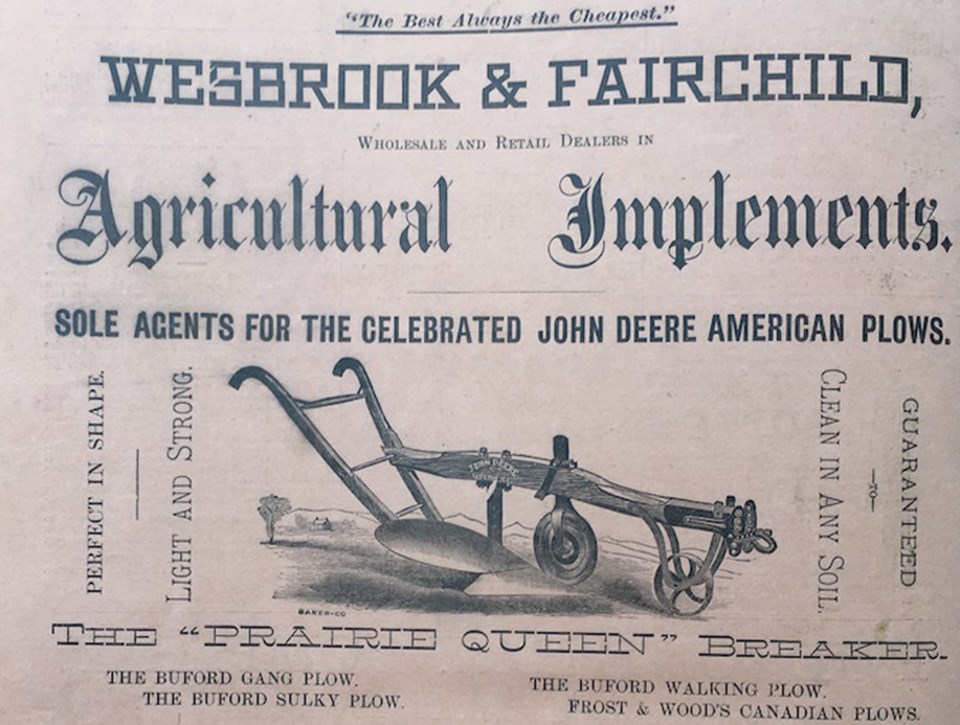The Nor-West Farmer and Manitoba Miller ran competitive essay competitions in 1888. The essay was to be one page in length or less. A cash prize of $5 was offered, big money for the day. One essay topic was “How to Start a Quarter Section Farm: Hints to New Settlers”. Through 1888, three award-winning essays on this topic were printed in monthly editions of the Nor-West Farmer and Manitoba Miller. These essays contain useful information on the activities of Manitoba homesteaders.
This is the first installment of the third place essay by Keith Henderson of Lariviere.
SOME GOOD ADVICE
In the first place, secure as good a homestead as can be got, then buy a yoke of oxen and harness. Do not get them any younger than five years, as they will not stand the hard work if too young, or older than nine for oxen get slow after that age. That is all the stock needed the first year, for a single man. If the intending settler possesses a wife, he will need a cow, a few hens and a pig. One cow will be no trouble at all, as she will stay with the oxen, and will be a great help in providing food for the table; one pig can be kept on the odds and ends about the house, that would be otherwise wasted, and ten or twelve hens will scratch for a living. The less stock a new settler has the first summer, the better, as he will want all the time he has for breaking and backsetting, and preparing for the winter. He can haul rails to fence a pasture, and logs to build a granary and stables the first winter. The second summer, if he can afford it, let him get a two or three more cows, two or three sheep and some young pigs and a breeding sow. I would advise him, as soon as he can afford it, to buy a span of young fillies , six months old, and by the time his crop is too large for the oxen to handle, he will have a team of young mares to help do the work.
“John Deere plow ... is the best for breaking”
He will require when starting, a John Deere plow as it is the best for breaking, and is good at backsetting, an axe, a nail hammer, a shovel, a hoe, a grub hoe, a saw, a cooking stove, a saw, a cooking stove, a tent to live in while he is building his house, provisions to last himself and his family for two months and a half (by that time the breaking season will be over and he will have to go to the nearest town for a fresh supply), and a wagon to draw them off to his homestead. The first of May ought to see him there. The grass will then be sufficiently advanced to enable his oxen to line on it without any any old hay. If he has any oats, let him give them a feed once a day, but if not, they will do very well without it. The first thing to be done after he has pitched his tent , and made things as comfortable as he can for his family, is to select a building site.
IMPORTANCE OF WATER
If the settler is fortunate enough to find a spring, or a spring creek on his place, let him build near that, for he will find it very valuable for both the house and stock; or if there are no water advantages to be had, and he has both homestead and pre-emption (a plot of land adjacent to the homestead that the settler had the right to purchase) let him choose a site on the corner of the homestead, as near the preemption as he can find a suitable spot, for, if he builds on the west end of his homestead, and his preemption is on the east end of it, he will have half a mile to travel to his work and a half mile to travel back again, every day he works on his preemption, and in a few years he will be working both homestead and preemption, and a man will find it very convenient to be near his work. Now, if he is satisfied with the building site, let him commence at once to dig a well, so he will be sure of good water before he goes to the expense of putting up any buildings. After the first six feet is dug, it will require two men. Dig the well six feet wide, keeping as near that as possible all the way down. Water may be found at twelve feet, and it may be necessary to dig twenty or twenty-five before water is struck, it depends a good deal on the locality. When you strike water, if it does not rise, sink the well three feet deeper, so you will then have three feet of water in it. If it comes in as fast as it is used, three feet is better than ten, for it is always fresh; too much water in a well gets brackish. If stone can be had near the place, crib the well with it, if possible, one foot above the water, from that up any kind of lumber or poles will do, by putting four pieces of timber, about five inches square, in every four feet, to keep the well from falling in. If stone is plenty use that all the way up. Raise the crib three feet above the surface, and fill all around it with earth that is taken out, to prevent any surface water from going in the well. If stone cannot be had, use spruce timber for it will not taint the water as readily as pine, popular or oak.
Continued next week




